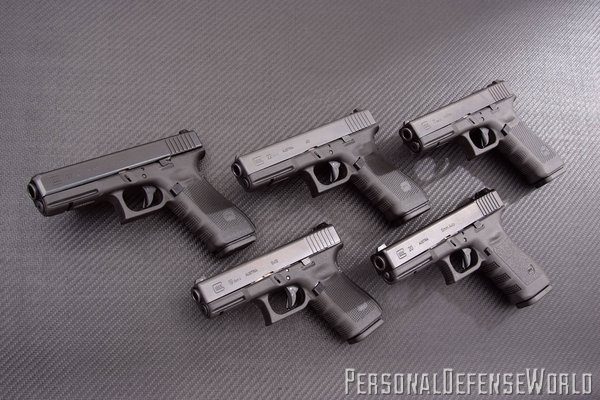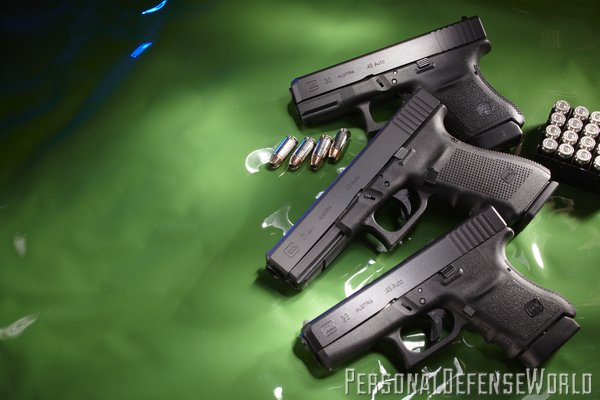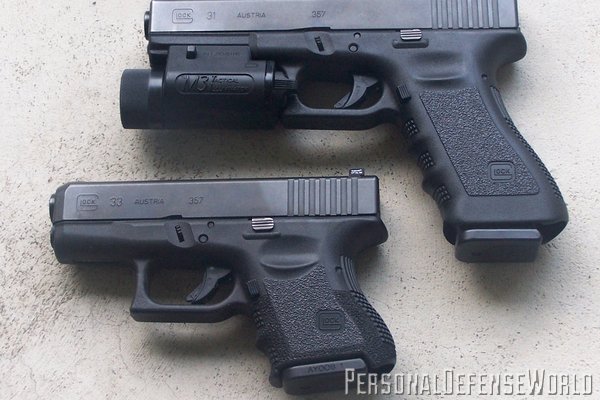Available in the United States for more than a quarter of a century now, the Glock pistol dominates market here. There are many good reasons why, and one of them is its versatility. Let’s look at the broad array of Glocks presently available. One or the other will probably serve your particular needs a bit better than the rest.
Size
The very first Glock, the Glock 17, established itself as a “service pistol” par excellence. That length, in turn, became the “standard size” Glock: a 4.5-inch barrel with slide of commensurate length, and a full-length grip-frame housing a full-length magazine.
Advertisement — Continue Reading Below
That Glock 17, now in its fourth generation of design advancement, is chambered for the 9×19 cartridge, also known as 9mm NATO,9mm Luger, and 9mm Parabellum. Safe to carry fully loaded with a round in the chamber, it holds 17 more in its standard magazine.
In 1990, the same Glock format was introduced chambered for the then-new .40 S&W cartridge. Known as the Glock 22, this pistol is believed to be in use by more American police departments than any other. Its standard magazine capacity is 15 rounds.
Next, Glock chambered the same gun for the .357 SIG cartridge, and called it the Glock 31. That bottlenecked round shares overall length and case head dimensions with the .40, so by simply interchanging the barrels the shooter can change his Glock .357 to .40, or vice versa. Glock 31 magazines will work with .40, and Glock 22 magazines will work with .357 SIG cartridges.
Advertisement — Continue Reading Below
With one caveat, the Glock 37 pistol in caliber .45 GAP is the same size as the pistols listed above. That one difference is slide thickness: on the Glock 37, the slide is wider, sufficiently so that it comes standard with the oversize slide-stop lever that is merely optional on the other standard size service models. A Glock 37 magazine is designed to hold ten rounds of .45 GAP.
Standard Compacts
“Standard compacts” sounds like a contradiction, but is used here intentionally to describe the frame size of the standard models made shorter at muzzle and butt. The first of these, going back to the late 1980s, was the Glock 19. Take the Glock 17, shorten the barrel by half an inch and the slide proportionally, and stub off the butt until you can only fit 15 9mm rounds in the magazine, and you have the original compact, the Glock 19.
Advertisement — Continue Reading Below
The same format in .40 is the Glock 23, and in .357, the Glock 32. Each of those will hold thirteen cartridges in their standard magazines. That size Glock in .45 GAP is the Glock 38, which comes with an eight-round magazine.
Standard Subcompacts
In the mid-1990s, Glock hit the next level of miniaturization with the pistols that instantly became known as the “baby Glocks,” the Glock 26 and Glock 27, soon to be followed by the Glock 33 and eventually, the Glock 39. A generation of cops has proven that these guns are small enough to carry in ankle holsters as hideout backups; in fact, at this writing, troopers of one state with Glock 27s and troopers of another with Glock 39s are required to carry these issue baby Glocks in issue ankle rigs to back up their full-size service Glocks whenever working in uniform. With sufficiently capacious trousers, they have been successfully carried in pocket holsters by some users.
Advertisement — Continue Reading Below
The Glock 26, probably the most popular of its size range today, carries ten 9mm rounds in its short little standard magazine. The Glock 27 carries nine rounds of .40, and the Glock 33, nine .357 cartridges. The fat .45 GAP cartridges top a Glock 39 magazine at six rounds.
Long Slides
The standard (i.e., Glock 17) size is actually the middle ground of “original frame” Glocks in size, with two models longer.
The first of those, going back to the 1980s, was the 6-inch barrel with proportional length slide. Dubbed the Glock 17L in 9mm, it would be known as the Glock 24 in .40. In either caliber, these guns take the same full-length magazines as the standard models. These are now only produced sporadically to meet demand when warranted, having been largely supplanted by Glock’s own Tactical/Practical series.
Advertisement — Continue Reading Below
Tactical/Practicals
By the turn of the 21st century, Glock had come out with guns in a length between standard and target length, their barrels 5.3 inches long and specifically engineered to fit the “footprint” of maximum sizes mandated for two of America’s most popular action shooting sports. Called the “Tactical/Practical” Glocks, the Glock 34 in 9mm took Glock 17 magazines and was destined to become the most popular Stock Service Pistol in the International Defensive Pistol Association, while the Glock 35 in .40 used the same magazine as the Glock 22 and proved immensely popular in Limited class shooting under the auspices of the International Practical Shooting Confederation. Some departments that appreciated the accuracy potential afforded by the long sight radius of the Tactical/Practical have bought them as standard issue for police patrol. The Glock 34 and Glock 35 are roughly the same size as Government Model 1911s.
Larger Frames
Advertisement — Continue Reading Below
In 1990, Glock introduced the Glock 20 pistol, essentially a scaled-up Glock 17 whose larger frame contained 15+1 rounds of full-power 10mm. While the 10mm cartridge itself did not take off in popularity as expected, the Glock 20 proved to be the most rugged 10mm auto out there when fired constantly with full power ammunition, and quickly became a “cult favorite” among fans of the caliber. Its compact version, the Glock 29 with 10-round magazine packs an amazing amount of ballistic potential for a gun its size.
Almost immediately after the Glock 20 came out, Glock introduced the same format in .45 ACP, the Glock 21. This 13+1 round pistol became the most popular standard-issue .45 ACP in American police circles. By the late 1990s, it had been joined by a chopped and channeled version, the 10+1 round Glock 30. Both pistols were remarkably accurate and soon established themselves as highly reliable. .45 fans particularly liked how “soft shooting” they were for their caliber, something 10mm Glock fans discovered also.
Slimline Glock
Advertisement — Continue Reading Below
After many years of public demand for a thin Glock with a single-stack magazine, the company introduced the Glock 36. Its magazine isn’t all that thin, but with six rounds in the mag and a seventh safely in the firing chamber, its firepower is ample for many buyers’ perceived needs. The caliber is .45 ACP.
Hand Fit
No one will do their best driving in a vehicle whose seat and steering wheel aren’t properly adjusted to them, and no one will do their best shooting with a pistol that does not fit their hands. Glock has gone in multiple directions to allow for customer hand fit. Glock’s SF (short frame) models have less distance front to back, allowing “more hand around the gun and more finger on the trigger.” The current Gen4 Glocks achieve that as they come out of the box, and also come with backstrap spacers to tailor grip girth and trigger reach for larger hands and/or longer fingers. Folks with the smallest hands may be candidates for that slim-line Glock 36, which has the thinnest grip configuration and the shortest reach to the trigger of any Glock.
Advertisement — Continue Reading Below
Tailoring
The reason Glock makes so many pistols is that the market wants them, and it wants them because so many customers have such divergent needs. Glock doesn’t have a cheap line and a deluxe line—none of the old Sears, Roebuck “good, better, best” approach to product. Their high quality is uniform throughout the line. The differences are found in
size and power level.
While I know many people who carry full size Glocks concealed year round, and my friend and ace instructor Tom Givens wears a 5.3-inch Glock 35 holstered inside his waistband daily, the compacts and subcompacts are the ones generally seen as the “concealment guns.” Consider the Glock range of “compacts” described above.
The Glock 19 has won many a match for famed instructor “Super Dave” Harrington of Team Panteao, even though it’s not perceived as a “match gun.”
On the NYPD, where officers have a choice of three different 16-shot 9mm pistols for uniform carry, an estimated 20,000 of the city’s estimated 35,000 sworn personnel carry the Glock 19.
The lightest of the city-approved duty guns, it is compact enough for plainclothes carry in an investigative assignment or off duty, yet substantial enough for uniform duty wear. Its .40 caliber twin, the Glock 23, is standard issue for FBI agents (who have the option of the service-size Glock 22 if they prefer). The Glock 23 is also standard issue for all divisions of the Boston Police Department, and its versatility in both uniformed and plainclothes roles is
one reason why.
Glock’s subcompact pistols are famous for being remarkably accurate for their size. It is not uncommon to see one outshoot its full-size counterpart in the same caliber. In addition to the mechanics, there is the matter of ergonomics and overall “shootability.” Several times in recent years, at GSSF (Glock Sport Shooting Foundation) matches, the overall top shot has tallied that “Matchmeister” score with a subcompact 9mm Glock 26. Mike Ross and Bryan Dover come to mind.
“Well, heck,” some might say. “Those guys are so good they could outshoot everybody else with anything.” Um…it’s not just that. I’m told that on those days, both men shot those winning scores in the Subcompact division. They were also shooting their bigger 9mm Glocks in the Master Stock division. They beat everyone, including themselves, who was using the bigger guns. That says something pretty impressive, not just about Dover and Ross, but about the
little Glock 26 pistol.
That said, it was the longer barreled Glock 34 (his signature pistol) that Bob Vogel used to shoot his way to the World Championship of the International Defensive Pistol Association last year. As noted earlier, that’s the single most popular handgun, not just the most popular Glock, at the IDPA Nationals every year. The long sight radius is very forgiving in terms of accuracy, and because the front part of their slides are cut away to make them lighter, the Tactical/Practical Glocks are not clunky or muzzle-heavy in feel. In fact, swinging a Glock 35 is a little like waving a wand compared to some of the old-style all-steel pistols it has superseded.
Caliber Question
Caliber will also be a huge part of the answer to the question, “Which Glock should I buy?” The new shooter in par-ticular is well served with a 9mm, due to both its mild recoil and its relatively low cost compared to the other available calibers. With careful ammunition selec-tion, the 9mm is a sound choice today for defensive purposes…and, of course it has room on board for a bit more ammunition, gun size for gun size. The lighter recoil also makes it the caliber of choice for some types of competition. The .45 caliber always inspires confidence in a police or defensive pistol, and its larger diameter tears bigger holes if the bullet’s hollow nose plugs on heavy clothing in cold weather environments. Glocks chambered for the standard 45 Auto round give higher capacity than most of the competition in the big Glock 21 or the compact Glock 30, and for those with smaller hands the standard-frame Glocks in .45 GAP deliver essentially the same level of stopping power. .45 ACP won’t exceed .45 GAP in power unless you go to a +P load.
If the debate between 9mm and .45 causes as much angst in the shooter as it has in many law enforcement agencies, the shooter can follow the police path and compromise on the .40, which Glock offers in all sizes.
An increasing number of police de-partments have gone with the powerful .357 SIG cartridge, such as the Tennessee Highway Patrol, which issues the Glock 31. With 125-grain hollow points, this high-velocity round has earned an excellent reputation for “stopping power,” and for tactical barricade penetration.
Its velocity also gives it a flat trajectory
for long shots.
Glock has been known to produce other calibers for markets outside the United States. The Glock in caliber 9×21 is popular in Italy, where private citizens are forbidden to own military caliber guns. One South American nation reportedly permits its citizens to carry only .32 or smaller caliber handguns; a Glock in .30 Luger would be ideal there. Glock produces compact and subcompact .380s as well, though they’re not imported into the U.S.
There are .22 LR conversions units available, affording inexpensive practice with the Glock. The one from Advantage Arms gets uniformly good reviews. This writer would like to see Glock bring out their own rimfire for their next product, which in the logical line of company product numbering, would be the fortieth. If the Glock 22 is a .40, it seems only fair that the Glock 40 should be a .22.
Triggers
Determined to be “double-action-only” by the Bureau of Alcohol, Tobacco, Firearms and Explosives, Glock’s Safe Action trigger is available in multiple formats. The standard is the 5.5-pound with standard trigger return spring, designed to give an overall pull of that weight. The shooter will experience a two-stage pull, rather like an old Springfield or Mauser bolt-action rifle trigger. The first stage is a relatively long, light take-up, followed by a shorter completing movement with more resistance. Glock shooters find it easy to “ride the link,” allowing the trigger to return forward from the last shot only until the sear engagement is felt, and then repeating the press.
Some police departments, such as Miami PD and the San Bernardino County Sheriff’s Department, have over the years seen fit to install heavier connectors in their issue Glocks. This would be the 8-pound. Butch Barton, who won more Gunny Challenge Glock matches than anyone else, long favored this set-up in his Glocks because he felt it gave him a crisper release. The 8-pound connector has not become widely popular elsewhere, however.
On the other end of the scale is the 3.5/4.5-pound connector, which debuted with the Glock 17L match pistol. Now known by the 4.5 pound designation, it registers that weight when the trigger is pulled from the center, where most of us place the index finger, and can go down to 3.5 pounds due to leverage when weighed at the bottom, or toe, of the trigger. Very popular among competitive shooters, it is sternly warned against by Glock for “duty pistols” or self-defense guns, unless used in conjunction with a New York style trigger return spring unit.
Twenty-some years ago, at the behest of the New York Police Department, Glock created the New York Trigger, now known as NY-1. This device replaces the standard trigger return spring and gives a firm resistance to the still-two-stage trigger from the very beginning of the pull. When mated with the 5.5-pound connector, the NY-1 brings pull weight up into the 7- to 8-pound range. A Mid-western state police agency pioneered the practice of mating the 3.5-pound connector with the NY-1, which gave a very smooth and uniform pull in the 6-pound weight range. This combination has been Glock approved for duty/defense guns across the board for several years now. For NYPD, Glock also developed a “New York Plus” module, now known as the NY-2, which with the standard 5.5-pound connector brings pull weight up into the 11- to 12-pound range. To my knowledge, it is used only by NYPD and the New York State Parole Board.
This writer recommends following Glock’s guidelines and only going with the 3.5/4.5-pound total pull in a competition gun. Some wonder why that system is standard in the Tactical/Practical guns; they need to look at the Glock website (glock.com) and observe that those pistols are listed under the Sport Shooting and Enthusiast categories, and not under Police, Military, or Personal Defense. It is Glock’s policy to ship Glock 34s and Glock 35s ordered by police departments with the standard 5.5-pound trigger system, and it is worth noting that when the Kentucky State Police adopted the Glock 35, they ordered them with NY-1 triggers.
Final Notes
The most popular police handgun in America, the Glock is also hugely popular for action pistol competition and home and personal defense, and in 10mm or .357 SIG can be a very useful outdoorsman’s sidearm, too. There’s pretty much a Glock for everyone, but it’s up to the shooter to identify his or her needs, and then determine which page to mark in the Glock catalog. To learn more, call 770-432-1202 or visit glock.com.

























